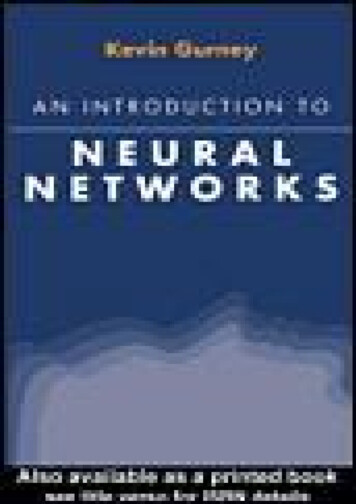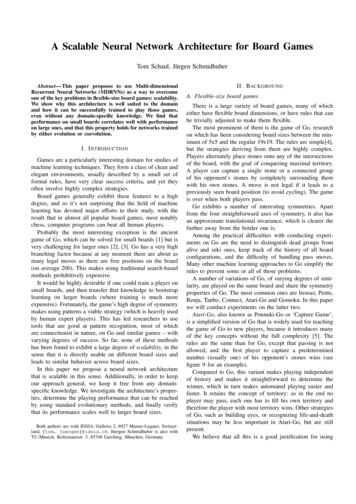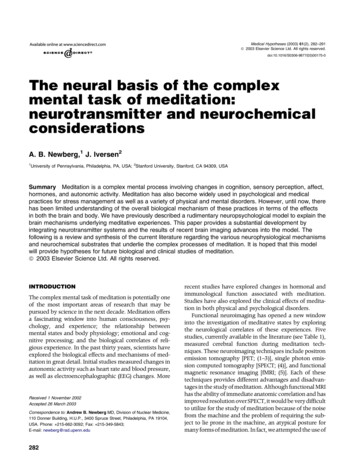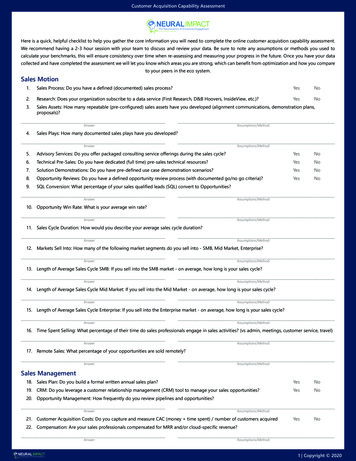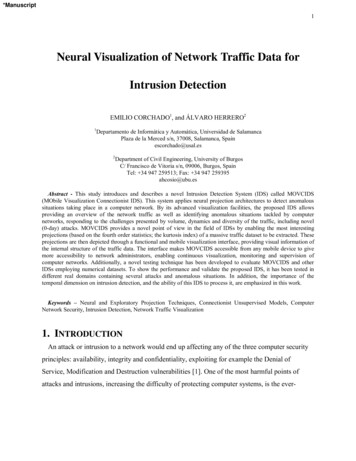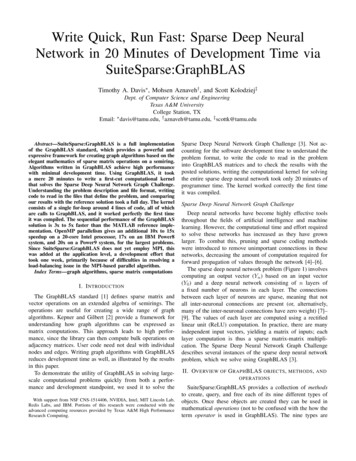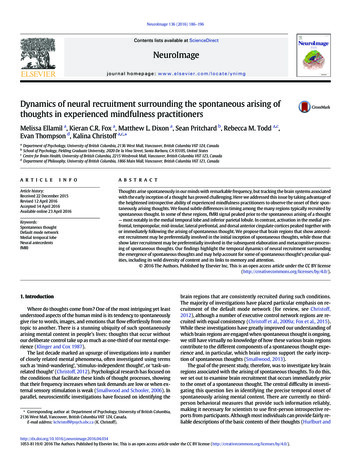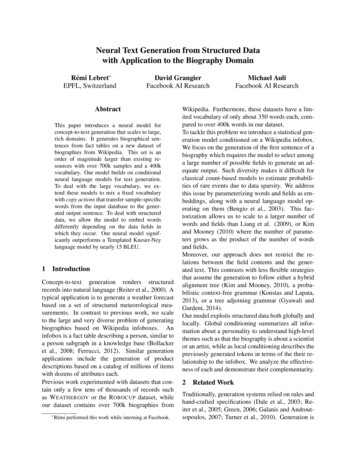
Transcription
Neural Text Generation from Structured Datawith Application to the Biography DomainRémi Lebret EPFL, SwitzerlandDavid GrangierFacebook AI ResearchAbstractThis paper introduces a neural model forconcept-to-text generation that scales to large,rich domains. It generates biographical sentences from fact tables on a new dataset ofbiographies from Wikipedia. This set is anorder of magnitude larger than existing resources with over 700k samples and a 400kvocabulary. Our model builds on conditionalneural language models for text generation.To deal with the large vocabulary, we extend these models to mix a fixed vocabularywith copy actions that transfer sample-specificwords from the input database to the generated output sentence. To deal with structureddata, we allow the model to embed wordsdifferently depending on the data fields inwhich they occur. Our neural model significantly outperforms a Templated Kneser-Neylanguage model by nearly 15 BLEU.1IntroductionConcept-to-text generation renders structuredrecords into natural language (Reiter et al., 2000). Atypical application is to generate a weather forecastbased on a set of structured meteorological measurements. In contrast to previous work, we scaleto the large and very diverse problem of generatingbiographies based on Wikipedia infoboxes. Aninfobox is a fact table describing a person, similar toa person subgraph in a knowledge base (Bollackeret al., 2008; Ferrucci, 2012). Similar generationapplications include the generation of productdescriptions based on a catalog of millions of itemswith dozens of attributes each.Previous work experimented with datasets that contain only a few tens of thousands of records suchas W EATHERGOV or the ROBOCUP dataset, whileour dataset contains over 700k biographies from Rémi performed this work while interning at Facebook.Michael AuliFacebook AI ResearchWikipedia. Furthermore, these datasets have a limited vocabulary of only about 350 words each, compared to over 400k words in our dataset.To tackle this problem we introduce a statistical generation model conditioned on a Wikipedia infobox.We focus on the generation of the first sentence of abiography which requires the model to select amonga large number of possible fields to generate an adequate output. Such diversity makes it difficult forclassical count-based models to estimate probabilities of rare events due to data sparsity. We addressthis issue by parameterizing words and fields as embeddings, along with a neural language model operating on them (Bengio et al., 2003). This factorization allows us to scale to a larger number ofwords and fields than Liang et al. (2009), or Kimand Mooney (2010) where the number of parameters grows as the product of the number of wordsand fields.Moreover, our approach does not restrict the relations between the field contents and the generated text. This contrasts with less flexible strategiesthat assume the generation to follow either a hybridalignment tree (Kim and Mooney, 2010), a probabilistic context-free grammar (Konstas and Lapata,2013), or a tree adjoining grammar (Gyawali andGardent, 2014).Our model exploits structured data both globally andlocally. Global conditioning summarizes all information about a personality to understand high-levelthemes such as that the biography is about a scientistor an artist, while as local conditioning describes thepreviously generated tokens in terms of the their relationship to the infobox. We analyze the effectiveness of each and demonstrate their complementarity.2Related WorkTraditionally, generation systems relied on rules andhand-crafted specifications (Dale et al., 2003; Reiter et al., 2005; Green, 2006; Galanis and Androutsopoulos, 2007; Turner et al., 2010). Generation is
divided into modular, yet highly interdependent, decisions: (1) content planning defines which parts ofthe input fields or meaning representations shouldbe selected; (2) sentence planning determines whichselected fields are to be dealt with in each outputsentence; and (3) surface realization generates thosesentences.Data-driven approaches have been proposed to automatically learn the individual modules. One approach first aligns records and sentences and thenlearns a content selection model (Duboue and McKeown, 2002; Barzilay and Lapata, 2005). Hierarchical hidden semi-Markov generative models havealso been used to first determine which facts to discuss and then to generate words from the predicates and arguments of the chosen facts (Liang et al.,2009). Sentence planning has been formulated as asupervised set partitioning problem over facts whereeach partition corresponds to a sentence (Barzilayand Lapata, 2006). End-to-end approaches havecombined sentence planning and surface realization by using explicitly aligned sentence/meaningpairs as training data (Ratnaparkhi, 2002; Wong andMooney, 2007; Belz, 2008; Lu and Ng, 2011). Morerecently, content selection and surface realizationhave been combined (Angeli et al., 2010; Kim andMooney, 2010; Konstas and Lapata, 2013).At the intersection of rule-based and statistical methods, hybrid systems aim at leveraging human contributed rules and corpus statistics (Langkilde andKnight, 1998; Soricut and Marcu, 2006; Mairesseand Walker, 2011).Our approach is inspired by the recent success ofneural language models for image captioning (Kiroset al., 2014; Karpathy and Fei-Fei, 2015; Vinyals etal., 2015; Fang et al., 2015; Xu et al., 2015), machine translation (Devlin et al., 2014; Bahdanau etal., 2015; Luong et al., 2015), and modeling conversations and dialogues (Shang et al., 2015; Wen et al.,2015; Yao et al., 2015).Our model is most similar to Mei et al. (2016) whouse an encoder-decoder style neural network modelto tackle the W EATHERGOV and ROBOCUP tasks.Their architecture relies on LSTM units and an attention mechanism which reduces scalability compared to our simpler design.Figure 1: Wikipedia infobox of Frederick Parker-Rhodes. Theintroduction of his article reads: “Frederick Parker-Rhodes (21March 1914 – 21 November 1987) was an English linguist,plant pathologist, computer scientist, mathematician, mystic,and mycologist.”.3Language Modeling for ConstrainedSentence generationConditional language models are a popular choiceto generate sentences.We introduce a tableconditioned language model for constraining thesentence generation to include elements from facttables.3.1Language modelGiven a sentence s w1 , . . . , wT composed of Twords from a vocabulary W, a language model estimates:P (s) TYP (wt w1 , . . . , wt 1 ) .(1)t 1Let ct wt (n 1) , . . . , wt 1 be the sequence of n 1 context words preceding wt s. In an n-gramlanguage model, Equation 1 is approximated asP (s) TYP (wt ct ) ,(2)t 1assuming an order n Markov property.3.2Language model conditioned on tablesAs seen in Figure 1, a table consists of a set offield/value pairs, where values are sequences ofwords. We therefore propose language models that
input text (ct , zct zctJohn Doe18 April 1352Oxford UKplaceholderJane DoeJohnnie Doe(name,2,1) (spouse,2,1)(children,2,1))isa18 124(birthd.,1,3) (birthd.,2,2) (birthd.,3,1) output candidates (w W nk )(spouse,2,1)(children,2,1)Figure 2: Table features (left) for an example table (right).are conditioned on these pairs.Local conditioning refers to the informationfrom the table that is applied to the description of thewords which have already generated, i.e. the previous words that constitute the context of the languagemodel. The table allows us to describe each wordnot only by its string (or index in the vocabulary)but also by a descriptor of its occurrence in the table. Let F define the set of all possible fields f . Theoccurrence of a word w in the table is described bya set of (field, position) pairs. mzw (fi , pi ) i 1 ,(3)where m is the number of occurrences of w. Eachpair (f, p) indicates that w occurs in field f at position p. In this scheme, most words are described bythe empty set as they do not occur in the table. Forexample, the word linguistics in the table of Figure 1is described as follows:zlinguistics {(fields, 8); (known for, 4)},(4)assuming words are lower-cased and commas aretreated as separate tokens.Conditioning both on the field type and the positionwithin the field allows the model to encode fieldspecific regularities, e.g., a number token in a datefield is likely followed by a month token; knowingthat the number is the first token in the date fieldmakes this even more likely.The (field, position) description scheme of the tabledoes not allow to express that a token terminates afield which can be useful to capture field transitions.For biographies, the last token of the name field isoften followed by an introduction of the birth datelike ‘(’ or ‘was born’. We hence extend our descriptor to a triplet that includes the position of the tokencounted from the end of the field: mzw (fi , p (5)i , pi ) i 1 ,where our example becomes:zlinguistics {(fields, 8, 4); (known for, 4, 13)}.We extend Equation 2 to use the above informationas additional conditioning context when generatinga sentence s:P (s z) TYP (wt ct , zct ) ,(6)t 1where zct zwt (n 1) , . . . , zwt 1 are referred to asthe local conditioning variables since they describethe local context (previous word) relations with thetable.Global conditioning refers to the informationfrom all the tokens and fields from the table, regardless whether they appear in the previous generatedwords or not. The set of fields available in a tableoften impacts the structure of the generation. For biographies, the fields used to describe a politician aredifferent from the ones for an actor or an athlete. We
introduce global conditioning on the available fieldsgf asP (s z, gf ) TYP (wt ct , zct , gf ).(7)t 1Similarly, global conditioning gw on the availablewords occurring in the table is introduced:P (s z, gf , gw ) TYP (wt ct , zct , gf , gw ).(8)t 1Token provide information complementary to fields.For example, it may be hard to distinguish a basketball player from a hockey player by looking only atthe field names, e.g. teams, league, position, weightand height, etc. However the actual field tokenssuch as team names, league name, player’s positioncan help the model to give a better prediction.Here, gf {0, 1}F and gw {0, 1}W are binaryindicators over fixed field and word vocabularies.Figure 2 illustrates the model with a schematic example. For predicting the next word wt after a givencontext ct , we see that the language model is conditioned with sets of triplets for each word occurringin the table, along with all fields and words from thistable.3.3Copy actionsSo far we extended the model conditioning by features derived from the fact table. We now turn tousing table information when scoring output words.In particular, sentences which express facts froma given table often copy words from the table.We therefore extend our language model to predict special field tokens such as name 1 or name 2which are subsequently replaced by the corresponding words from the table; we only include field tokens if the field token is actually in the table.Our model reads a table and defines an output domain W Q of vocabulary words W as well as alltokens in the table Q, as illustrated in Figure 2. Thisallows the generation of words which are not in thevocabulary. For instance Park-Rhodes in Figure 1is unlikely to be part of W. However, Park-Rhodeswill be included in Q as name 2 (since it is the second token of the name field) which allows our modelto generate it. Often, the output space of each decision Q W is larger than W. This mechanismis inspired by recent work on attention based wordcopying for neural machine translation (Luong et al.,2015) as well as delexicalization for neural dialogsystems (Wen et al., 2015). It also builds upon olderwork such as class-based language models for dialogsystems (Oh and Rudnicky, 2000).4A Neural Language Model ApproachA feed-forward neural language model (NLM) estimates P (wt ct ) in Equation 1 with a parametricfunction φθ , where θ refers to all the learnable parameters of the network. This function is a composition of simple differentiable functions or layers.4.1Mathematical notations and layersIn the paper, bold upper case letters represent matrices (X, Y, Z), and bold lower-case letters representvectors (a, b, c). Ai represents the ith row of matrixA. When A is a 3-d matrix, Ai,j represents the vector of the ith first dimension and j th second dimension. Unless otherwise stated, vectors are assumedto be column vectors. We use [v1 ; v2 ] to denote vector concatenation. In the following paragraphs, weintroduce the notation for different layers used in ourapproach.Embedding layer. Given a parameter matrixX RN d , the embedding layer is a lookup tablethat performs an array indexing operation:ψ X (xi ) Xi Rd ,(9)where Xi corresponds to the embedding of the element xi at row i. When X is a 3-d matrix, the lookuptable takes two arguments:ψ X (xi , xj ) Xi,j Rd ,(10)where Xi,j corresponds to the embedding of thepair (xi , xj ) at index (i, j). The lookup table operation can be applied for a sequence of elementss x1 , . . . , xT . A common approach is to concatenate all resulting embeddings: ψ X (s) ψ X (x1 ); . . . ; ψ X (xT ) RT d . (11)Linear layer. It applies a linear transformationto its inputs x Rn :γ θ (x) Wx b(12)where θ {W, b} are the trainable parameterswith W Rm n the weight matrix, and b Rm a
bias term.Softmax layer Given a context input ct , the final layer outputs a score for each next word wt W,φθ (ct ) R W . The probability distribution is thenobtained by applying the softmax activation function:exp(φθ (ct , w))P (wt w ct )
biographies from Wikipedia. This set is an order of magnitude larger than existing re-sources with over 700k samples and a 400k vocabulary. Our model builds on conditional neural language models for text generation. To deal with the large vocabulary, we ex-tend these models to mix a fixed vocabulary with copy actions that transfer sample-specific words from the input database to the gener .

